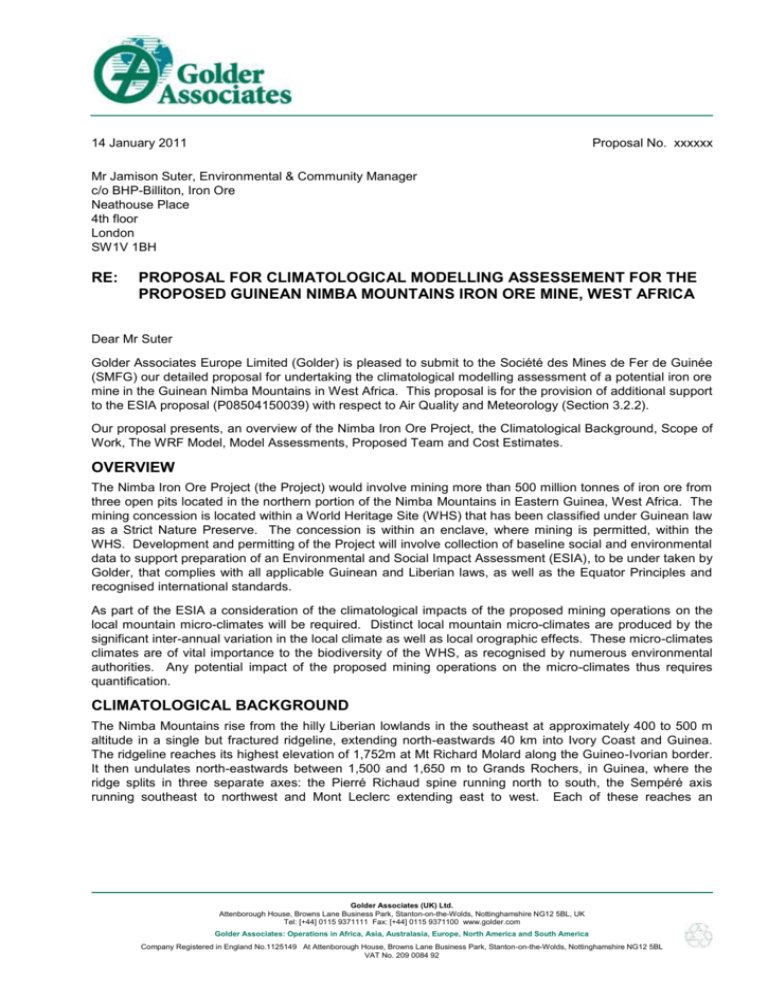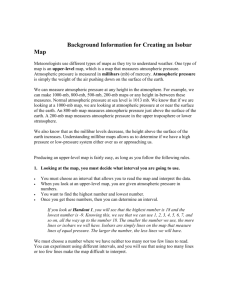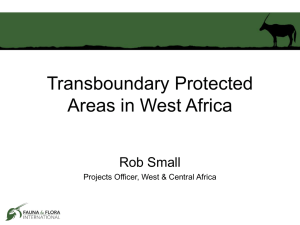climatological background
advertisement

14 January 2011 Proposal No. xxxxxx Mr Jamison Suter, Environmental & Community Manager c/o BHP-Billiton, Iron Ore Neathouse Place 4th floor London SW1V 1BH RE: PROPOSAL FOR CLIMATOLOGICAL MODELLING ASSESSEMENT FOR THE PROPOSED GUINEAN NIMBA MOUNTAINS IRON ORE MINE, WEST AFRICA Dear Mr Suter Golder Associates Europe Limited (Golder) is pleased to submit to the Société des Mines de Fer de Guinée (SMFG) our detailed proposal for undertaking the climatological modelling assessment of a potential iron ore mine in the Guinean Nimba Mountains in West Africa. This proposal is for the provision of additional support to the ESIA proposal (P08504150039) with respect to Air Quality and Meteorology (Section 3.2.2). Our proposal presents, an overview of the Nimba Iron Ore Project, the Climatological Background, Scope of Work, The WRF Model, Model Assessments, Proposed Team and Cost Estimates. OVERVIEW The Nimba Iron Ore Project (the Project) would involve mining more than 500 million tonnes of iron ore from three open pits located in the northern portion of the Nimba Mountains in Eastern Guinea, West Africa. The mining concession is located within a World Heritage Site (WHS) that has been classified under Guinean law as a Strict Nature Preserve. The concession is within an enclave, where mining is permitted, within the WHS. Development and permitting of the Project will involve collection of baseline social and environmental data to support preparation of an Environmental and Social Impact Assessment (ESIA), to be under taken by Golder, that complies with all applicable Guinean and Liberian laws, as well as the Equator Principles and recognised international standards. As part of the ESIA a consideration of the climatological impacts of the proposed mining operations on the local mountain micro-climates will be required. Distinct local mountain micro-climates are produced by the significant inter-annual variation in the local climate as well as local orographic effects. These micro-climates climates are of vital importance to the biodiversity of the WHS, as recognised by numerous environmental authorities. Any potential impact of the proposed mining operations on the micro-climates thus requires quantification. CLIMATOLOGICAL BACKGROUND The Nimba Mountains rise from the hilly Liberian lowlands in the southeast at approximately 400 to 500 m altitude in a single but fractured ridgeline, extending north-eastwards 40 km into Ivory Coast and Guinea. The ridgeline reaches its highest elevation of 1,752m at Mt Richard Molard along the Guineo-Ivorian border. It then undulates north-eastwards between 1,500 and 1,650 m to Grands Rochers, in Guinea, where the ridge splits in three separate axes: the Pierré Richaud spine running north to south, the Sempéré axis running southeast to northwest and Mont Leclerc extending east to west. Each of these reaches an Golder Associates (UK) Ltd. Attenborough House, Browns Lane Business Park, Stanton-on-the-Wolds, Nottinghamshire NG12 5BL, UK Tel: [+44] 0115 9371111 Fax: [+44] 0115 9371100 www.golder.com Golder Associates: Operations in Africa, Asia, Australasia, Europe, North America and South America Company Registered in England No.1125149 At Attenborough House, Browns Lane Business Park, Stanton-on-the-Wolds, Nottinghamshire NG12 5BL VAT No. 209 0084 92 Mr Jamison Suter, Environmental & Community Manager c/o BHP-Billiton, Iron Ore xxxxxx 14 January 2011 elevation of approximately 1,650 m. The Nimba Mountains have an altitudinal gradient of over 1,000 metres from lowland to summit. The regional climate affecting Mount Nimba has been described as humid and equatorial - tropical which becomes increasingly dry Sahel and Saharan towards the North (Lubke and Branch, 2000). This is contributed by two main weather systems, the south westerly tropical monsoon which brings humid coastal air northwards during the wet season and a series of convectively initiated precipitation events and the north easterly ‘Harmattan’ winds which bring dry dusty air from the African Sahelian desert. Lubke and Branch (2000) state that the dry season occurs in the months between December and early March and the wet season occurs in the months between mid March and November with most rain falling between the months of March and October. There can however be significant interannual variability. The orographic effect of the steep and varied terrain is thought to influence significantly the local meteorology (UK Met Office, 2007 and 2008). The UK Met Office stated that characterisation of rainfall in the Nimba Project area is complex and influenced by a number of factors including aspect, elevation, season and exposure to wind. The area to the west of Mount Nimba, lies within a rain shadow, and thus receives lower rainfall (Lubke and Branch, 2000), but this area is also thought to be partially protected from the dry Harmattan winds during the dry season that can depress local relative humidity and thus lower rainfall potential (UK Met Office, 2008). SCOPE OF WORKS It is understood that during proposed mineral extraction the elevation of mountain peaks within the mining enclave will be reduced. There are three mounts that have been selected for iron ore open pit mining at Nimba, namely, Pierré Richaud, Signal Sempéré and Chateau. The Pierré Richaud pit would involve mining from the summit for approximately 350 m reducing the elevation to approximately 1,300 m. The Signal Sempéré pit would involve mining for approximately 240 m reducing the elevation to approximately 1,400 m. The Chateau deposit would be mined to an unknown pit depth. SMFG has indicated that the ESIA should assess all three pits. An understanding of the potential impacts of the change in the local orography on the local mircro-climate is required. In particular, any changes to the local air flow, cloud formation and precipitation is required to determine if there is likely to be any adverse impact on the specialised species living within the WHS. Any climatological assessment for the site must therefore include a detailed representation of the local orography and the significant seasonal and interannual variation in the regional climate. A bullet point summary of the proposed scope of works is provided below. Further details of the proposed climatological modelling assessment are provided in the following sections. It is proposed to assess the environmental change in the surface orography and surface properties by excavation of peaks in the Nimba hills to retrieve iron ore by: using the Weather Research Forecasting Model (WRF). The Weather Research Forecasting Model (WRF) is recognised throughout the world as a leading research tool (http://www.ucar.edu/news/releases/2006/wrf.shtml); using a state of the art code that can be used to model convection and that can upscale and downscale the important processes that effect the regional climate; an examination of the regional rainfall probability distribution and the effects on the local climate region climate, over an annual basis, including both the dry and wet season (i.e. consideration of seasonal variations); modelling the before and after changes for existing climate conditions, one El-Niño, one La Niña and two “normal” years, and compare the results (i.e. a consideration of the significant interannual variability which is known to exist); and production of a flexible and open access modelling tool that can be used at a later date to assess further different scenarios as required. 2/6 Mr Jamison Suter, Environmental & Community Manager c/o BHP-Billiton, Iron Ore xxxxxx 14 January 2011 THE WRF MODEL The Weather Research Forecasting Model (WRF) has over 15,000 users, is constantly being tested and improved, is internationally recognised and currently, approximately one third of the world receive weather forecasts generated by it. As a forecasting tool, it is relatively slow compared with weather forecast models from the UK Met office and other similar institutions, due to the way it steps forward in time (Eulerian rather than semi-Lagrangian), but therein lies its advantage for research work, as it has many conserving properties, is much more flexible, and more suitable for detailed studies and two way nesting. Figure 1 shows an example of the configuration proposed for the nested domains of the WRF for the proposed Nimba mining project. The four, two way nested domains have resolutions of 200 m in the inner domain (domain number 4) reducing to 15 km in the outer domain (domain number 1). The inner domain is designed to be of a resolution suitable for capturing the detail of the Nimba mountains and hence potential impacts to changes in the local orography (which are reductions in the vertical scale of approximately 300 m on average). An inner domain of any larger scale is considered unlikely to capture all of the potential changes to the flow characteristics. All the explicit convection and flow characteristics can be described in this local domain. The outer domain of the model is driven by global fields from large scale atmospheric data sets such as those produced by the US National Centers for Environmental Prediction (NCEP) or European Centre for Medium Range Weather Forecasts (ECMWF). A major advantage of the WRF model is that the convection and wave motions generated in the inner domains are transmitted to the outer domains, such that the larger scale flow includes the effects of the upscaling of energy. Most atmospheric forecast models are one way nesting (i.e. the flow in the inner domains does not impact on the outer domains). WRF can be run in both one way and two way nested schemes, but despite the increase in computational cost, in this application it is important that the upscaling of convection from the high resolution local scale domains feeds into the larger scale regional flows. Figure 1: The four, two way nested domains, with resolutions of 200 m inner domain (domain number 4), 600 m (domain number 3), 3 km (domain number 2) and 15 km outer domain (domain number 1). With a 3:1 nesting ratio proposed for the Nimba project, the middle domains remain suitable to simulate convection (and precipitation) and are of sufficient size to resolve large storm features; the 3 km resolution of domain 3 is the same as that used for forecasting storms in the American mid-west. Large scale 3/6 Mr Jamison Suter, Environmental & Community Manager c/o BHP-Billiton, Iron Ore xxxxxx 14 January 2011 teleconnections of weather with the Indian Monsoon are not possible with the two way nesting formulation of WRF. However, since the maximum size of the Nimba mine surface feature is only 2-3 km across, and would therefore not even be noticed by a model with a resolution of more than 1 km in that domain, it is considered that it is essential to adequately resolve the local small scale impacts. THE MODEL ASSESSMENTS To assess the potential impact of the change in orography from the proposed mining excavations it is proposed to model simulation pairs, with and without the mountain excavations. The following wider climatic conditions, which include seasonal variations, will be considered: one driven in an El-Niño climate year regime; one driven in a La-Niña climate regime; one in a “wet” normal year; and one in a “dry” normal year. The modelling would take approximately 6 months to complete. The deliverables would be an agreed list of meteorological output variables such as rainfall probability distributions, number of days with rainfall, rainfall maximum and minimums, convective activity, cloud base data (which can be produced for domains 1, 2 and 3). These data would be analysed by meteorologists and atmospheric scientists within Golder to determine whether there is any impact on the local micro-climate of the proposed mining excavations. These data would also be important to the ecologists overseeing any potential impacts to biodiversity (and hence the list of deliverables is open for discussion prior to completion of the final proposal). PROPOSED TEAM The technical project team that Golder has assembled includes experienced UK Golder meteorologists and atmospheric scientists (Dr Stewart Davies and Dr Samantha Arnold), internationally respected academics from the University of Leeds (Dr Alan Gadian and Dr Ralph Burton), and a world renowned expert from the National Centre for Atmospheric Research in America (NCAR, Dr Greg Holland) who will provide external peer review. External peer review is considered vital to ensure that the quality of the results stand up to international scrutiny on such a potentially sensitive development within a WHS site. Continuity with the wider Nimba Project will be maintained through the experienced project management by Marion Thomas at Golder Associates. Further details regarding Golder Associates are available in the ESIA proposal (P08504150039). The work will be carried out in the Institute for Climate and Atmospheric Science (ICAS) in the School of Earth and Environment, University of Leeds. Dr Stewart Davies and Dr Samantha Arnold previously worked at ICAS and so have experience undertaking internationally important projects successfully with Dr Alan Gadian and Dr Ralph Burton. ICAS has over 20 academic staff, over 40 research and support staff, more than 50 PhD students and 20+ associates. ICAS’s research programme is at the forefront of atmospheric science, and has an active international observational research programme. ICAS has a very strong track record of research funding from external bodies such as the Natural Environment Research Council (NERC) and the European Commission, with over 40 research projects at any one time. It has a significant international reputation and attained a quality profile of 4* (15%), 3* (55%), 2* (25%) in the 2008 RAE. ICAS is also home to the Directorate of the National Centre for Atmospheric Science (NCAS), and the two scientists leading this study are NCAS staff. NCAS has a budget of £9 million per annum. to carry out research into Weather, Climate and Atmospheric Composition. NCAS provides scientific facilities for researchers across the UK to enable excellent atmospheric science on a national scale. These include a world-leading research aircraft, a ground-based instrumentation pool, access to computer models and facilities for storing and accessing data. ICAS provides the UK academic community and the Natural Environment Research Council with national capability in atmospheric science. The University of Leeds/NCAS is directly involved in WRF, contributing to the scientific core as well as hosting the biannual European teaching and research workshop, the next to be held in Edinburgh in the Autumn. NCAS has 4/6 Mr Jamison Suter, Environmental & Community Manager c/o BHP-Billiton, Iron Ore xxxxxx 14 January 2011 recently signed a memorandum of understanding with NCAR, MMM division, which will be of significant value to this project. Pen portraits of the proposed team are provided below and full CV’s are available on request. Marion Thomas, Golder Associates, Project Manager. As per ESIA proposal. Dr Samantha Arnold, Golder Associates, Senior Atmospheric Scientist. As per ESIA proposal. Dr Stewart Davies, Golder Associates, Senior Atmospheric Scientist. As per 2010 ESIA proposal. Dr. Alan Gadian, ICAS and NCAS Principal Investigator. Dr Gadian is an NCAS Scientist and Senior Research Lecturer in ICAS. Alan is the NCAS project manager of the UK microscale modelling activity. He has worked on aspects of numerical modelling for past 25 years. He currently has 2 PhD students working in areas of cloud physics, geoengineering and numerical methods in atmospheric modelling. He has developed cloud model to gain greater understanding of aspects of microphysics, dynamics, entrainment. He is also currently working on the international Convective and Orographically Induced Precipitation Study (COPS), which is relevant to this project, and is Leeds’ PI on the study of stratocumulus clouds (VOCALS). He is Editor-in-Chief of Atmospheric Science letters; external examiner for the University of East Anglia (Meteorology). Dr. Ralph Burton, NCAS, Co-Investigator. Dr Burton is a research scientist in NCAS Weather. He has worked on several topics in atmospheric science, including the use and development of complex numerical models of orographic flows, statistical analysis of atmospheric flow patterns, and numerical weather prediction. He has recently become a leading scientist in using WRF. He is also part of the NERC-funded Land-Based Renewables Project, part of whose aim is to create regional nesting of the WRF model within a global climate model. Ralph Burton has worked on various aspects of West African meteorology, mountain flows, and convection (see publications) for twelve years. He is an acknowledged expert on the use of WRF in the UK and has been invited (by national as well as international institutions) to give talks on its use, and has been author and co-author on various recent papers dealing with WRF simulations of convection. Dr Greg Holland, NCAR, External Reviewer. Dr Holland is director of the NCAR Earth System Laboratory. He is a leading international figure in Earth System Modelling, and was until recently Head of the Meso-scale and Micro-scale Modelling (MMM) division at NCAR. He is a member of the WMO Expert Committee on Hurricanes and Climate Change, a senior researcher in the Willis Research Network and chair of the NCAR Regional Climate Prediction Program. We appreciate the opportunity to provide you with our proposal and we look forward to discussing it with you. Yours sincerely. GOLDER ASSOCIATES (UK) LTD. Samantha Arnold Senior Atmospheric Scientist Stewart Davies Senior Atmospheric Scientist SA/SD/xx CC: [Click here and type list of CCs] Attachments: ICAS Relevant Publications List 5/6 Mr Jamison Suter, Environmental & Community Manager c/o BHP-Billiton, Iron Ore xxxxxx 14 January 2011 ICAS Relevant Publication List:- Barthlott, C., Burton, R. R., Kirshbaum, D., Hanley, K., Richard, E., Chaboureau, J-P., Trentmann, J., Kern, B., Bauer, H-S., Schwitalla, T., Keil, C., Seity, Y., Gadian, A., Blyth, A., Mobbs, S., Flamant, C., Handwerker, J. (2010). “Initiation of deep convection at marginal instability in an ensemble of mesoscale models: a case study from COPS”, Quarterly Journal of the Royal Meteorological Society, accepted for publication Bennett, L., Blyth, A., Burton, R. R., Gadian, A., Weckwerth, T., Behrendt, A., Di Girolamo, P., Dorninger, M., Lock, S.-J., Smith, V., Mobbs, S. (2010). “Initiation of convection over the Black Forest mountains during COPS IOP15a”, Quarterly Journal of the Royal Meteorological Society, accepted for publication Burton, RR, Vosper, SB, Mobbs, SD (2006). “Underlying structures in orographic flow: an analysis of measurements made on the Isle of Arran”, Quarterly Journal of the Royal Met. Society, 132, 1457-1466 Latham, J , P Rasch, C. Chen, L. Kettles, A.Gadian, A. Gettelman, H. Morrison, K. Bower & T. Choularton. 2010, "Global Temperature Stabilization", Geo-Engineering Climate Change: Environmental Necessity or Pandora's Box. Ed B.under, J. Michael & T. Thompson. CUP ISBN 978-0-521-19803-5. p207-28 Parker, DJ, Burton, RR, Diongu-Niang, A, Ellis, RJ, Felton, M, Taylor, CM, Thorncroft, CD, Bessemoulin, P and Tomkins, AM (2005). “The diurnal cycle of the West African monsoon circulation”, Quarterly Journal of the Royal Met. Society, 131, 2839-2860 Parker, DJ, Thorncroft, CD, Burton, RR and Diongue-Niang, A (2005). “Analysis of the African Easterly Jet using aircraft observations from the JET2000 experiment”, Quarterly Journal of the Royal Met. Soc., 131, 1461-1482 Mobbs, SD, Vosper, SB, Sheridan, PF, Cardoso, R, Burton, RR., Arnold, SJ, Hill, MK, Horlacher, V. and Gadian., AM (2005). “Observations of downslope windstorms and rotors in the Falkland Islands”, Quarterly Journal of the Royal Me.l Society, 131, 329-353. Younger, PM, A. Gadian, C-G. Wang, J. Freer, K. Beven. 2008. “The usability of 250 m resolution data from the UK Meteorological Office Unified Model as input data for a hydrological model” Met. Apps. 15, 2, 207-217. c:\users\stdavies\desktop\nimba climatology sd.docx 6/6









